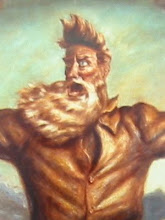The guys sawed up and went to the roof (that happened before I worked my way around to the charlie side of the building) but the order was rescinded before the holing commenced. As you can see, the stick did make it up and by all accounts the unit is working very well.
Sometimes, positive pressure produces the desired effect without all of the
Tiller trucks were made for this environment. Back in the day, our rear mounts would have made it in here, but it would have taken some work. I doubt that the crew from 2's had to think twice about working their way back into the complex and getting set up.
It's funny, but tiller trucks fell out of favor around this area in the late '70s and '80s. They never really went away, but the trend seemed to indicate that elevated platforms were going to be the truck of choice. Some thought they were going the way of the dinosaur. While the popularity of various types of units well ebb and flow, I think tillers will be around this department for a long time to come.
Even though this wasn't much of a job, the layout of the complex called for a bit of a hose lay to get into the unit and upstairs. From what I heard, a neighbor had done some decent work with a portable extinguisher, keeping things from getting out of hand and confined to an area within a room. While disappointing from a photography standpoint, it was a good thing for the occupant and for the crews.
I guess in this instance, size didn't matter. The hose still needed to be cleaned and loaded.
I'm quite sure that new Truck 2 will be confronted with lots of fire in the future. Some of it will challenge it and it's crews. When it does happen, I hope no one gets hurt, the loss is kept to a minimum and that I am there to capture it through the lens.
Thanks for reading,
Schmoe
.jpg)
.jpg)
.jpg)
.jpg)
.jpg)


Captain Schmoe,
ReplyDeleteThanks for writing.
I like the composition of that top photo. There's something pleasing in the way the smoke, the firefighters, and the ladder are arranged, and how the ladder and the roof separate a triangle of sky from the ground. I like that.
Do you mind a question? What is the hole in the roof for, and how does positive pressure (in this case) do whatever that hole would have done?
Thanks for sharing. You guys are awesome!
ReplyDeleteWayne - I liked that one too, one of the reasons I keep a wide angle zoom on my camera almost all of the time. Sometimes, I like to capture all of the activity an emergency scene provides at once, wide angles allow for that. Composure is often tough, you have to take what you can get.
ReplyDeleteAs far as the the hole goes, in a nutshell, it is to allow heat and smoke out of the fire area without introducing mass amounts of air into the the fire. The process is called vertical ventilation.
Heat, smoke and other products of combustion are produced in large quantities and are concentrated in the fire area. They are somewhat confined, building up to a point where everything in the space reaches it's ignition temperature.
We try to get there fast enough to interfere with that process by putting the fire out before that temperature is reached. Removal of the smoke/heat/gasses during the attack process lowers the temperature in the space, improves visibility and improves the atmosphere inside the space. All of these help us do our job better and improves the chances of survival for any victims.
We have three basic ways of removing the heat/smoke/gasses. Natural ventilation is as simple as opening an upwind window or door and a downwind window or door and letting nature do the work.
Mechanical is using blowers or fans to either blow the smoke out, suck the smoke out or to provide air positive pressure to force the smoke from the structure.
Vertical ventilation is using a hole cut in the roof of the structure to allow the heat to escape. Sometimes it is the only option as introducing air either from a fan or a window would cause the fire to rapidly and greatly intensify. Letting the heat out allows the crews to get in and take care of business before that happens.
In this case, the fire was not intense enough to justify damage to the roof and there was no need. A fan and some positive pressure was the right tool.
Basic ventilation techniques is a week long class, I hope a few paragraphs helps explain it.
Brigid - Those guys are awesome, they do a good job. My dragon slaying days are over, I now do battle with a computer, a camera lens and some unruly wiener dogs. Maybe not as much fun, but a little more serene.
Thanks for the comments.
From watching a few videos on YouTube and a bit of reading I've decided that that ventilation is more art than science.
ReplyDeleteAnd a black art at that.
BGM
Captain Schmoe,
ReplyDelete_Great_ explanation. Even more so if a know-nothing like me can understand it.
Thanks!
BG - It's not as mysterious as all that. It just takes education, training and experience. That and the engine crews not screwing up your ventilation plan!
ReplyDeleteWayne - Glad it helped.